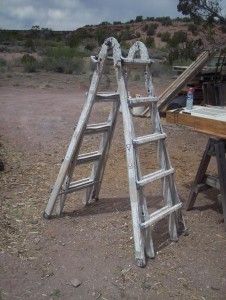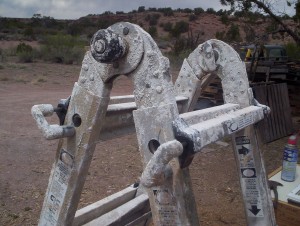 I don’t know how long ago, but before I ever moved here Landlady and T bought themselves one really good ladder. It has been involved in the construction of three houses and a barn, not to mention countless trips banging about in the back of the Jeep here or there. It’s been repeatedly coated with stucco, left in the rain, fallen in the wind, bashed with heavy things…
I don’t know how long ago, but before I ever moved here Landlady and T bought themselves one really good ladder. It has been involved in the construction of three houses and a barn, not to mention countless trips banging about in the back of the Jeep here or there. It’s been repeatedly coated with stucco, left in the rain, fallen in the wind, bashed with heavy things…
It was a darned good investment, and I’m speaking as the guy who didn’t have to pay for it. But I’d be lying if I said it withstood all that without showing any wear. For quite a while it really hasn’t worked all that well, to tell the truth. I used it to put up conduit in the barn last month, and it seemed like I spent more effort futzing with the ladder than with wiring.
Now I’m getting ready to side an entire (small) house with it, and got to thinking maybe a bit of lubrication might just possibly be in order… Yeah, you could say so. A few squirts of WD-40 seemed to take years of wear off the poor neglected thing. All of a sudden it’s working like new.
Yeah, you could say so. A few squirts of WD-40 seemed to take years of wear off the poor neglected thing. All of a sudden it’s working like new.
Maybe we need a PM comic for desert hermits, like the one the army’s published since somewhere around the indian wars…

















































WD 40, or duct tape, one or the other will fix most things
I’ve always loved the saying: If it moves and shouldn’t, use duct tape. If it should move and doesn’t, use WD40. Unfortunately, that doesn’t work nearly as well for plastic stuff. Sure wish things were not so often made of plastic. Especially the goofy combinations. I’ve seen things where plastic is used for the wear and pressure points, and nice shiny stainless steel used for the outer cover. How dumb is that?
Once again you have reminded me that what I do is normal. In a couple of days I will be taking down a shed and the ladder I have and will use is in the same condition as the one you are using. My bad… Well like you I will make it work with a little TLC. After all it was Red Green* who said “If the women don’t find you handsome, they should at least find you handy. ”
* https://www.youtube.com/watch?v=jv6MgODqMZc
In many cases, the “plastic” (covers a lotta territory) is much better for pressure/wear than most metals, while a stainless enclosure protects said points from weather and contamination. Just a matter of proper materials selection for the application at hand.
🙂
I’m not completely convinced any comparison with me is a proper measure of “normal,” MJR. 🙂
And I haven’t seen a Red Green episode in decades! I laughed my ass off, thanks.
I would imagine that is true in many cases, but the item that came to mind when I wrote that was an expensive coffee grinder. The shaft and assembly that held the metal blades was made of plastic. The plastic came apart and broke into fragments. The nice stainless steel “bowl” and outer housing of the motor are still beautiful, but the grinder is useless. I’ve had it long enough (about 2 years) that there is no recourse with the company, and any replacement would probably cost as much as the whole thing did originally, if replacements are even available. It’s a shame, since the motor is strong and the machine did an excellent job… for as long as the plastic held out. sigh
I recently bought a much less expensive grinder, and was very pleased to see that the hub holding the blade is metal… I can’t take it apart as I could with the other one, so don’t know about the shaft, but I have hopes this one will last a little longer.